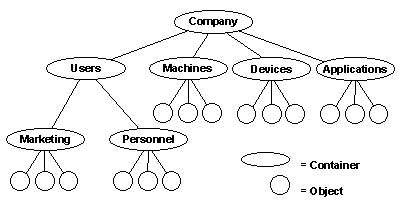| HOME |
| Active directory |
| Ip ports |
| IP |
| DHCP |
| LAN |
| VPN |
| DialUp |
| Ports |
| Web server |
| DNS |
| Sockets |
| X.25 |
| IIS |
| TCPIP |
The Windows 2000 directory service that stores information
about all objects on the computer network and makes this information easy
for administrators and users to find and apply. With the Active Directory,
users can access resources anywhere on the network with a single logon.
Similarly, administrators have a single point of administration for all
objects on the network, which can be viewed in a hierarchical structure.
Active Directory is an essential and inseparable part of the Windows 2000
network architecture that improves on the domain architecture of the Windows
NTŪ 4.0 operating system to provide a directory service designed for
distributed networking environments. Active Directory lets organizations
efficiently share and manage information about network resources and users.
In addition, Active Directory acts as the central authority for network
security, letting the operating system readily verify a user's identity and
control his or her access to network resources. Equally important, Active
Directory acts as an integration point for bringing systems together and
consolidating management tasks.
Combined, these capabilities let organizations apply standardized business
rules to distributed applications and network resources, without requiring
administrators to maintain a variety of specialized directories.

Active Directory provides a single point of management for Windows-based
user accounts, clients, servers, and applications. It also helps
organizations integrate systems not using Windows with Windows-based
applications, and Windows-compatible devices, thus consolidating directories
and easing management of the entire network operating system. Companies can
also use Active Directory to extend systems securely to the Internet. Active
Directory thus increases the value of an organization's existing network
investments and lowers the overall costs of computing by making the Windows
network operating system more manageable, secure, and interoperable.
| Doris Dumicic e-mail:doris3@net.hr |
| Ina Pendic mail:pendicka@yahoo.com |
How Does Active Directory Work?
Active Directory lets organizations store information in a hierarchical,
object-oriented fashion, and provides multi-master replication to support
distributed network environments.
Hierarchical Organization

Active Directory uses objects to represent network resources such as users,
groups, machines, devices, and applications. It uses containers to represent
organizations, such as the marketing department, or collections of related
objects, such as printers. It organizes information in a tree structure made
up of these objects and containers, similar to the way the Windows operating
system uses folders and files to organize information on a computer.
In addition, Active Directory manages the relationships among objects and
containers to provide a single, centralized, comprehensive view. This makes
resources easier to find, manage, and use in a highly distributed network.
The Active Directory hierarchy is flexible and configurable, so
organizations can organize resources in a way that optimizes their usability
and manageability.
In Figure 1 above, containers are used to represent collections of users,
machines, devices, and applications. Containers can be nested (created
one-inside-the-other) to reflect accurately the company's organizational
structure. In this case, marketing and personnel organization containers
represent those respective departments, and their relationship to one
another, within the company. Grouping objects in the directory lets
administrators manage objects on a macro-level (as collections) rather than
one-by-one. This increases management efficiency and accuracy while letting
organizations align network management with their business processes.